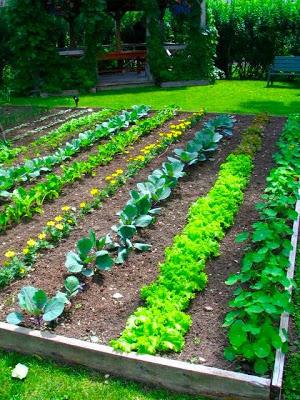 Although the idea of having fresh home grown vegetables is extremely appealing to most people not everyone follows through and makes their own vegetable garden, because it does involve hard work and dedication. But if you are one of those who have decided to grow backyard garden planning tips that will help you get started. You will find you need to think about the type of soil you have, what vegetables you can grow, where should it be positioned and planting.
Although the idea of having fresh home grown vegetables is extremely appealing to most people not everyone follows through and makes their own vegetable garden, because it does involve hard work and dedication. But if you are one of those who have decided to grow backyard garden planning tips that will help you get started. You will find you need to think about the type of soil you have, what vegetables you can grow, where should it be positioned and planting.Grow Backyard Garden Planning Tips – Location and the Soil
You should choose somewhere that gets a lot of direct sunlight and has good drainage. Ideally when growing vegetable garden you want soil that is fertile with texture and moistness. You can improve what you have already by adding organic humus. Create a compost in your garden that you can use to mix with your soil by digging a hole and then filling it with food leftovers, cuts and peels of vegetables not used, any rotting fruit and so on. All the degradable waste you and your family create can go on it and add some soil over it then leave for a few days. This can then by shoveled onto your vegetable garden. There are also various products that are organic that can be purchased.
Grow Backyard Garden Planning Tips – Planting
Once the soil is ready you can decide how you are going to organize the planting – in rows or on raised beds. Try to involve the whole family and remember you need small paths in between the different types you plant, to weed and harvest. Don't overcrowd an area, plants do better when they have room to grow. Also think about companion planting. Some plants do better when planted together, and some do worse. Here is a guide to a few of the common vegetables people like to grow and what they grow well with.
• Tomato – Very popular in most any vegetable garden great for salads, sauces, soups and much more. If you are planting tomatoes consider planting them with carrots, broccoli, asparagus, parsley, celery, brussel sprouts, chives or kale. Do not grow them with cabbage, kohlrabi or potatoes.
• Lettuce – Great for salads or sandwiches or wraps and grows well with most vegetables though does its best with radish, carrots, onion, strawberries and cucumbers.
Peas – Are great with any meal, and fresh peas taste far better than canned or frozen. Grow them with turnips, beans, carrots, corn or cucumbers but not with potatoes, onions, garlic or chives.
• Brassicas (Cabbage Family) – The cabbage family includes the vegetables broccoli, kale, cabbage, kohlrabi and cauliflower. Plant with lettuce, celery, onions, beets, cucumber, tomato, rosemary, sage but avoid planting with strawberries or pole beans.
• Celery – Versatile for salads, stews, soups, sauces and more the celery grows with most other plants well, but in particular with the tomato, bush beans, onion, or cabbage family.
• Onion and Garlic – Essential cooking ingredients in many households these should be planted with carrots, beets, parsley or lettuce but not with peas or beans.
• Bush Beans – These beans needs to be planted with corn, cucumber, strawberries, celery or potatoes and not with onions.
• Corn – Amazing how much better corn tastes fresh compared to can or frozen. If you want to grow this think about growing it with cucumber, potatoes, peas, beans, or pumpkin but keep away from the tomato plants.
• Asparagus – One of the more easy going vegetable garden plants that gets along with everyone! Yields its best though with parsley, tomato or basil.
• Potatoes – Could be the most eaten vegetable, chipped, roasted, mashed, fried, we love the potato! To get the best harvest grow them with cabbage, corn, beans, eggplant and not with pumpkin ( or any other squash for that matter) tomato or cucumber.
• Cucumber – Great in your salads, sandwiches, dips and so on, cucumbers do better with radish, beans, peas and corn but should not be grown with any aromatic herb or potatoes in your vegetable garden.
